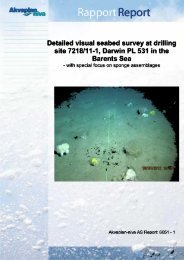A study of the priority substances of the Water Framework Directive ...
A study of the priority substances of the Water Framework Directive ...
A study of the priority substances of the Water Framework Directive ...
Create successful ePaper yourself
Turn your PDF publications into a flip-book with our unique Google optimized e-Paper software.
..:::::::::: dichloromethane<br />
..:::32<br />
11 Dichloromethane<br />
� Dichloromethane has main use as solvent, but<br />
diffuse emissions from PVC production also<br />
occurs.<br />
� Possible human and confirmed animal carcinogen.<br />
� There are no data on environmental distribution<br />
in Norway.<br />
� There is no need for fur<strong>the</strong>r screening and<br />
monitoring <strong>of</strong> dichloromethane.<br />
Production and use<br />
Dichloromethane is produced toge<strong>the</strong>r with<br />
methylchloride and chlor<strong>of</strong>orm. In Sweden its<br />
use has been banned since 1996, but exceptions<br />
are possible. In Norway it's been used as a solvent<br />
in <strong>the</strong> pharmaceutical industry, for paint<br />
stripping, for aerosols, for adhesives and for<br />
o<strong>the</strong>r applications such as metal degreasing,<br />
foam blowing (after <strong>the</strong> fluorocarbon ban),<br />
chemical processing, secondary refrigerant medium<br />
etc. It is also known to be used in certain<br />
types <strong>of</strong> glues for PVC, as degreaser and paint<br />
remover and in <strong>the</strong> production <strong>of</strong> polyurethane.<br />
Volumes in Norway are unknown.<br />
Emissions, discharges,<br />
distribution and hot-spots<br />
There have been diffuse emissions to air from<br />
Hydro Polymers (PVC-production). O<strong>the</strong>r emissions<br />
are mainly through products. Dichloromethane<br />
may be expected to leak from landfills.<br />
Monitoring<br />
There has been no screening or monitoring <strong>of</strong><br />
dichloromethane in Norway. There are no data<br />
on environmental distribution in Norway.<br />
Need for fur<strong>the</strong>r screening and monitoring<br />
The use in Norway is very limited and occurrence<br />
in water is not considered to be a problem.<br />
No fur<strong>the</strong>r screening or monitoring is necessary.<br />
Analysis<br />
The analysis <strong>of</strong> dichloromethane is <strong>of</strong>ten part <strong>of</strong><br />
packages with several o<strong>the</strong>r volatile organic<br />
compounds (VOC).<br />
Methods<br />
The methods are based on purge-and-trap, or<br />
head-space analysis and separation and quantifi-<br />
A <strong>study</strong> <strong>of</strong> <strong>the</strong> <strong>priority</strong> <strong>substances</strong> <strong>of</strong> <strong>the</strong> <strong>Water</strong> <strong>Framework</strong> <strong>Directive</strong><br />
TA-2140/2005<br />
FACTS<br />
Cas no.: 75-09-2<br />
Synonyms: Diklormetan, methylene chloride, methylene<br />
dichloride, aero<strong>the</strong>ne, DCM, Freon 30, metandiklorid,<br />
metylendiklorid, metylenklorid.<br />
Properties: Colourless liquid, sweet odour like chlor<strong>of</strong>orm.<br />
Toxic effects: Minimum observed effect level for<br />
short-term inhalation exposure <strong>of</strong> dichloromethane<br />
was approximately 690 mg/m3. Lethal dose for<br />
humans (oral) is 25 ml while LD50 (rat oral) is<br />
between 1600 and 3000 mg/kg body weight (WHO).<br />
Dichloromethane is also a probable human carcinogen,<br />
confirmed animal carcinogen and irritant to skin<br />
on repeated contact. LC50 Daphnia magna = 224<br />
mg/l/48 hour.<br />
Log Kow: 1,3 (calculated)<br />
Persistence: Volatile in soil and water (evaporation).<br />
Half-life in air 50-119 days. Half-life in water 4 days.<br />
Half-life in soil 7-107 days (CIRCA and HSDB)<br />
<strong>Water</strong> solubility: 13,7 g/l at 20°C<br />
Molecular formula: CH 2 Cl 2<br />
Metabolites: Formaldehyde, and formic acid and<br />
inorganic chloride (human).<br />
cation with GC-based methods: GC/MS or<br />
GC/ECD.<br />
Synergy with o<strong>the</strong>r analyses<br />
Sample preparation and quantification can be<br />
co-ordinated with <strong>the</strong> analysis <strong>of</strong> o<strong>the</strong>r VOC<br />
like compounds or o<strong>the</strong>r halogenated and nonhalogenated<br />
solvents.<br />
References<br />
� CIRCA, Royal Haskoning: Fact sheets on<br />
production, use and release <strong>of</strong> <strong>priority</strong> <strong>substances</strong><br />
in <strong>the</strong> WFD, Dichloromethane , Final<br />
version 31 January 2001<br />
� HSDB: Dichloromethane<br />
� World Health Organization; Environmental<br />
Health Criteria 32. METHYLENE CHLORIDE.<br />
Geneva, Switzerland. 1984<br />
� Direktoratet for arbeidstilsynet, 2000:<br />
Grunnlag for fastsettelse av administrativ norm<br />
for diklormetan

















